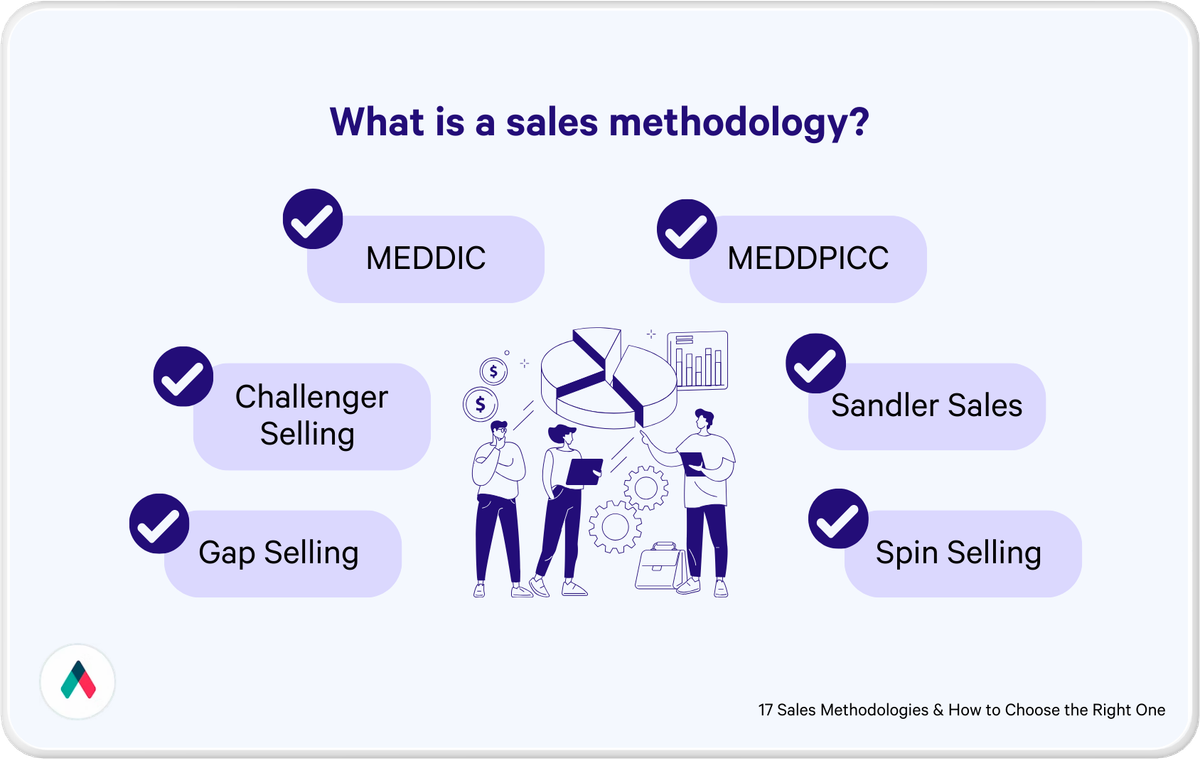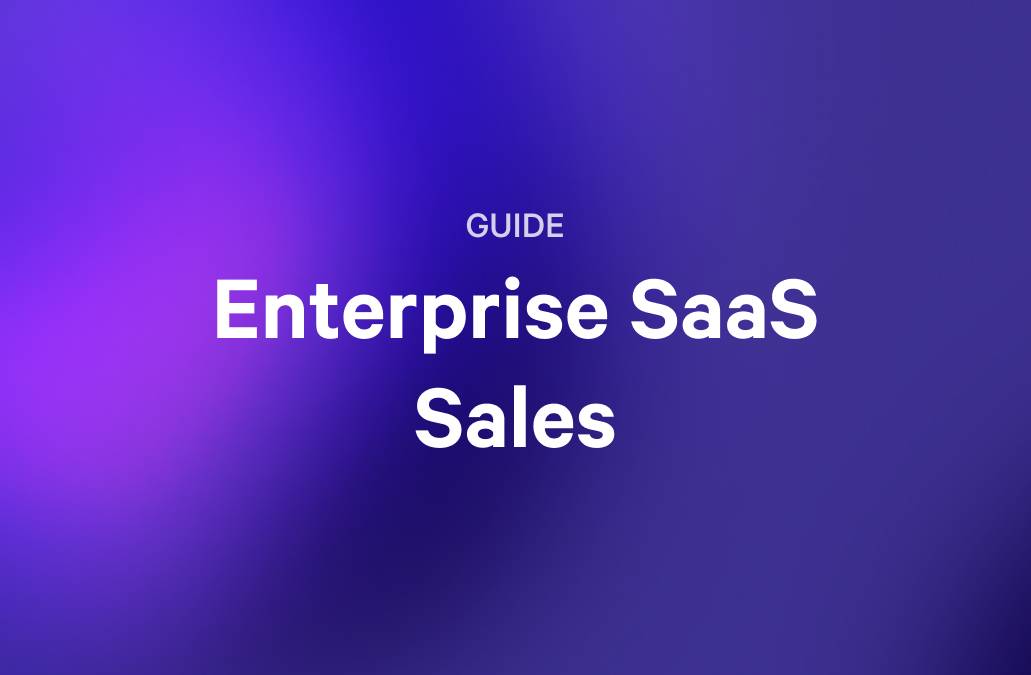Enterprise sales.
Even the name sounds big and audacious.
For many organizations, having the opportunity to craft large deals and deliver services to enterprise organizations is the dream. And if you want to live it? You need to be ready to be strategic and execute flawlessly.
To help you get started and sell enterprise deals in today’s economic environment, we’ve put together some of the best practices and strategies for success.
Key takeaways:
- Enterprise sales involve large deals with longer sales cycles, larger buying groups, and higher price tags.
- Benefits of enterprise sales include consistent revenue, brand reputation enhancement, and the ability to build long-term relationships with customers.
- Creating an enterprise sales model involves determining your Go-To-Market motion, positioning your product or service, selling in smaller increments, and enabling your team to sell.
- Improving your enterprise sales process can involve creating a repeatable client engagement strategy, leveraging competitive intelligence, understanding data about your sales cycle, and holding post-mortems after key deals.
What is enterprise sales?
Before we dive in, let’s make sure we’re all on the same page about what we’re even talking about.
Enterprise sales, sometimes called complex sales, is the process of selling to large companies. These types of sales generally have longer sales cycles, larger buying groups, and, ultimately, higher price tags (and higher sales commissions!).
When working in enterprise sales, you might encounter several competitors who are also bidding on the same business. Learning to articulate your competitive advantages and differentiators from these competitors clearly will help you to close more deals.
What you don’t want to do in this environment is compete solely on price, or it will always be a race to the bottom which will hurt both your organization’s profitability and your sales team’s commissions or bonuses.
Psst, check out Qwilr's new sales growth rate calculator next
What are the benefits of enterprise sales?
Enterprise sales can be higher risk and higher reward for organizations and business development teams, but they come with some serious benefits. These include:
Consistent revenue for years
Because enterprise sales come with longer contracts and higher dollar values, they can provide your organization with consistent revenue for many years.
For example, if you sell billing software to a business with a 20-person accounting team at $99/seat per month, you’re looking at bringing in $1980 per month or $23,760 per year from this one deal. Should this business love your software and remain a customer for ten years, you’re looking at bringing in $237,600 over the contract's life.
That example is possibly on the low end for an enterprise saas sales contract.
So, let’s look at something like a digital marketing agency that sells digital marketing and website maintenance services. An average contract might contain hours for web maintenance (running updates, adding pages, building new components), SEO, PPC, analytics, and content creation. The agency charges $10,000 per month for the retainer and has an hourly rate for any work needed beyond what the retainer allows for.
This contract could be worth $120,000- $150,000 per year, depending on how much extra work is needed. Over ten years, the agency may bill this customer over 1.5 million dollars (assuming some cost increases and some additional work).
Larger contracts like the ones in these examples can help a business scale up quickly. Money will come in consistently, and some of the revenue can be reinvested in additional team members, better technology, or R&D for new products or services.
Brand reputation
The type of companies that need (and can afford) enterprise-level contracts and large-scale services are often well-known and well-respected businesses. Having these logos and case studies to promote will help your company build your reputation too.
Using the same accounting software or CRM that big players trust may appeal to potential new customers, whether they’re also enterprise-level customers or SMBs. If you sell to more than one type of customer, promoting the household name companies you work with can bring credibility and be a solid marketing strategy.
Remember to ensure your smaller customers understand your experience working with customers of their type and size. No one wants to feel like they’re too small potatoes or undervalued or won’t get the right level of customer support.
Ability to build long-term relationships with customers
Because of the deal sizes and the length of the sales cycle in enterprise sales, the sales rep and other team members need to focus on building long-term relationships with key stakeholders. These relationships are imperative when driving deals forward and can be leveraged to get information from the customer’s organization that can help the team put together a winning proposal.
The benefits of building these relationships start early in the sales cycle and will carry through the life of the contract. Customer onboarding, retention meetings, and day-to-day operations will provide a lot of time to spend with the customer and their key decision makers.
Good relationships at multiple levels of the customer organization can help solidify your status as the preferred vendor and prevent the customer from “shopping” regularly for a better deal.
Understanding your customer’s pain points and coming up with plans to eliminate or mitigate them over the contract's life can also help you remain a preferred vendor and build customer trust.
How do you create an enterprise sales model?
If the benefits of an enterprise sales strategy appeal to you and your organization, you might be wondering how to implement one.
Since we’ve already mentioned that the enterprise sales cycle can be significantly longer than its more transactional counterpart, there is some urgency to get the plan right from the start so that you can start signing up customers, close deals, and bring in revenue as quickly as possible.
And, with enterprise sales, getting potential customers to sign is just the beginning. You need to make sure you’re signing the right size and type of deals so you aren’t also battling customer churn at the same time. While some churn is natural, and some may argue that it is good for growth, you want to avoid losing too many customers too quickly.
Determine your Go-To-Market (GTM) Motion
When building an enterprise sales model, the first thing you want to do is choose a GTM motion. The three most common GTM motions used by b2b Saas companies are:
- Bottom Up: The bottom-up motion is sometimes referred to as product-led growth. In this motion, the potential customer often starts with a freemium or open-source version of the product before moving to a paid plan. Examples of well-known companies using this motion include Slack, Asana, Zoom, Dropbox, Webflow, and Canva.
- Middle Out: The middle out motion is where the product resonates with multiple individual contributors across several teams. Products that work well for a middle-out motion are usually those in the middle of an enterprise tech stack and may require some customization (and the price tag that comes with it). Some examples of SaaS companies that use a middle-out motion are MongoDB, Crossbeam, and Confluent. The average contract size for a product using a middle-out motion is usually higher than those that use a bottom-up.
- Top Down: The third most popular GTM motion is the top-down motion. In this motion, the process is driven by sales leadership and the sales team, with a healthy assist from marketing. Since this is the oldest of the three motions, it may feel a little dated to modern sales professionals. This doesn’t mean it’s worth discounting. In this motion, the sales process is very much driven through direct communication with members of the potential customer’s C-Suite. This motion relies on the buying influence of an executive choosing the vendor, product, or service for the entire organization. For SaaS companies like Oracle or Salesforce.com, this motion may still be the most effective. Because of the large area of responsibility of the executives making these decisions, contracts won using a top-down motion may be the most lucrative and have the highest lifetime value.
Decide how you will position your product or service in the market
Once you’ve chosen your GTM motion, you’ll want to start working on positioning your product or service in the marketplace. The first thing you want to think about is your ideal customer’s needs and how to differentiate your product or service from anything else your competitors may be offering.
In this phase of building your enterprise sales model, you’ll be looking at your customer profiles (personas), their needs, interests, motivation, and budgets and creating the positioning statement and talking points that account executives or sales reps will use when talking with potential customers.
Try selling in smaller increments
Jake Dunlap, CEO of Skaled Consulting, shares the same advice with many of his clients looking to move into enterprise sales.
“There's a very logical way that larger companies buy or people make very big purchases".
He further explains that there is usually a proof of concept, which is a smaller group testing something to see if it works, and that there's a proof of scale, or the potential for scaling the product or service to a region or geographic area or whatever the vertical might be.
Following this proof of scale and rollout to a larger area, the organization will see the success or value and roll it out to the broader organization. As a sales professional himself, he was able to take a deal from nothing to $4M in ten months by using this process.
When selling enterprise, Jake shares that the biggest issue he sees is that salespeople will try to jump ahead and try to sell a large number of seats or licenses, say 2000, in the first run. And no one buys like that. The other mistake he warns sellers not to make is to try to lock potential customers into an annual agreement. He says doing this often forces no decision.
Instead, he recommends enterprise sellers build a plan with their clients based on success at each phase in the process. So, if there is success at the proof of concept phase after a set period of time, then they agree to roll out to a full region. Once there is success in the region, maybe they add another region, and so forth, and so on, until the entire organization has bought in.
Enable your team to sell
You’ve decided on your overarching messaging and some strategies for selling your product or service, but you can’t just hand some talking points over to your reps and expect them to knock it out of the park. Sales enablement is critical to the success of the entire operation.
If you’re building from scratch, start by thinking through various touchpoints your sales reps will have with potential customers. For an enterprise sales cycle, touchpoints may hit the double digits as the sales cycle is significantly longer, and there may be more people involved in making a final decision on the client side. There will be follow-ups to the follow-ups and meetings after the meetings.
You’ll want to arm your team with playbooks that include email outreach templates, phone call and demo scripts, social proof (examples), and even proposal templates that they can leverage when the time comes to make a formal bid for the business.
At Qwilr, we know something about creating proposals to delight enterprise customers. Our enterprise proposal software allows enterprise sales teams to create proposals that contain video, call recordings, and other interactive elements like ROI calculators and pricing options that can be adjusted based on the number of seats or pricing tiers. We also have specific enterprise sales proposal templates and SaaS proposal templates to work with.
We don’t just provide proposal capabilities; you and your team can leverage Qwilr’s capabilities to create anything a salesperson might need to share at any point in the sales process. This includes sales collateral that can be tailored and then shared across the buying team and contracts or Nondisclosure agreements that can be easily signed, executed and captured in minutes.
Build and reinforce enterprise sales skills with training and continuing education
Creating messaging and playbooks for sales professionals in an enterprise environment is great, but it’s not enough. Having a sales enablement plan for consistent training and reinforcing learning is critical to the success of your enterprise sales model.
With the long sales cycle in an enterprise deal, there is a lot to learn and remember to keep things moving and improve the quality of the sales process and, ultimately, the quality of the deal. In an enterprise company, you should consider having the following training process built into your fiscal year.
Sales Kickoff
While some people loathe the sales kickoff meeting, it can be a great opportunity to inspire and educate your sales team. From recognizing successes in the last fiscal year to aligning on the strategy moving forward, a lot of great energy can come from holding this type of meeting. In addition, it allows distributed sales teams to come together and build relationships. Selling can be lonely, and having the opportunity to bond as a team can be important for enterprise sellers.
When creating your sales kickoff meeting, keep the agenda focused on recognition, inspiration, strategy, and education!
Quarterly Training
Sales kickoff meetings should not be the only time your team gets together to talk strategy and share best practices. A rotation of quarterly training or skill-building workshops can help reinforce areas of opportunity and upskill the sales team.
These training sessions can focus on sales methodology, leveraging new technology or sales automation, or general training around sales best practices. While the latter might not be sexy or cutting edge, consistently reinforcing the basics drives results.
Monthly reinforcement sessions
Training as an isolated incident each quarter may not get you the results you’re looking for. Giving sales team members opportunities to practice what they’ve learned, ask questions, or get additional support around challenging parts of the sales process can help your team members grow into better sales professionals.
As the market and b2b sales trends evolve, the skills your team will need to win in the marketplace will also evolve, so having dedicated time to work through challenges is important.
Ongoing coaching and support
One of the most important roles a sales manager plays is that of a coach. Whether in team meetings, regularly scheduled 1:1s, or at the request of a team member, coaching and support should be happening consistently for every seller.
Coaching can be formal during a meeting or informal when reviewing client communications or replaying a particularly challenging sales call. Having candid conversations between enterprise sales professionals and their leaders can provide support when needed and encourage growth.
4 ideas to improve your enterprise sales process
For teams with enterprise sales processes up and running, it might be time to consider evaluating the process and making some improvements. These four ideas can help move the needle, but deciding which to prioritize, will depend largely on what’s working and what’s not.
So the first order of business should be to take an in-depth review of your sales metrics and the full sales cycle to see what’s really going on. Then, you can easily hone in on where you might want to make some improvements in sales performance.
1. Create a repeatable client engagement strategy
As we’ve already discussed, enterprise clients may need some time to consider your product or service (which can lead to a longer sales cycle), and building relationships is critical. So, one way you might consider improving your sales strategy is to come up with a consistent client engagement strategy your salespeople can leverage.
This strategy may also be called an enterprise account plan and has some similarities to Miller Heiman’s Large Account Management Strategy (LAMP) or the Gold Sheet.
To do this, simply you will want to have each salesperson identify their top 10 target accounts. These can be accounts they have already started developing relationships with or accounts they dream of signing!
Next, have them map out all of the buying influences in the organization and create an annual plan to keep building the relationship. For the day-to-day person, consider monthly engagement. These engagements could be as simple as an email or as involved as a dinner out. For the c-suite or those who are important to the deal but less involved, determine the right level and types of engagement. These could be quarterly or even just two to three times per year.
It might make sense to bring sales leaders or other executives into the engagements with their counterparts on the buying team. Sales team members can coordinate with leaders to prioritize these types of sales engagements and ensure these meetings are productive for everyone.
2. Leverage competitive intelligence
There are many ways to learn about what your competitors are doing out in the marketplace. For example, setting Google alerts, following them on LinkedIn (and setting them as leads if you use Sales Navigator), and checking local and national business publications can tell you a lot without investing a lot of time or money.
If your team is ready to invest in this area, tools like Outreach, Demandbase, and Zoominfo can be helpful and provide additional insights and relevant contact information.
3. Collect and understand data about your sales cycle
There’s an old expression about what gets measured gets managed, but we want to be a little more specific here. Measuring and managing the right things in your sales cycle can help you and your team understand what is working and where you have opportunities to improve when winning new business.
The specific things that matter most in your sales cycle will vary from organization to organization. But, one thing to keep in mind is that having some consistency so you can collect data that is apples to apples is important. If you have a team of 6 enterprise salespeople and they are all working in completely different ways, you can’t begin to collect data and understand what is working.
So, when teams are being asked to try to manage the way prospects move through the sales funnel or what collateral or data points are shared and when consistently, it is to gather data about the effectiveness of the process or materials.
4. Hold post mortems and use win/loss forensics after key deals as learning opportunities for sellers and the full team
While there are very few opportunities for do-overs in sales, being able to look back at a deal and think about why it was won or lost and if there is anything the seller should have done differently is a powerful tool.
Holding a post-mortem and using tools like win/loss forensics to dig into how a deal went down and why a buyer made their particular decision can give sales teams so much valuable information for next time.
Through these processes, you might learn that the buyer chose a competitor because of a family relationship or because a college fraternity brother is the sales VP. And while these things are largely out of your control, you may learn about some things you can influence next time.
For example, if in a post-mortem you learn that the buying team felt that the salesperson was leaning too hard on one feature that the buyer didn’t value - maybe next time, dig into the features that matter most or ask clarifying questions along the way will help.
The most important thing is to make post-mortems and any forensic reporting a safe space to learn and ask questions. Even in deals we win, there are areas to improve. So, if the team can create a culture where mistakes are celebrated, and learning is rewarded, these conversations become more valuable and actionable. It will also encourage team members to take risks and try new things; even if they don’t work, there is something to be gained from having tried.
FAQs
Is Enterprise Sales a good idea for startups?
With long and complex sales cycles, enterprise sales may not be the best option for startups right out of the gate. Many startups elect to target small or medium-sized businesses for early customers as they have fewer decision-makers and shorter sales cycles, which means revenue may be coming in faster than waiting for an enterprise deal to close.
What are the main differences between enterprise sales and transactional sales?
The main difference between enterprise sales and more transactional sales is the length of the sales cycle and the number of people who need to weigh in on the decision. For example, the decision to replace one copy machine may be a transactional sale, and one person might do some research and make a purchase. In contrast, replacing all of the copy machines in a 15-story high rise would be considered an enterprise sale with more people looking at the purchase decision and possibly a formal RFP sent to several copy machine suppliers.
What are the four stages of enterprise sales?
The four stages of enterprise sales are discovery, diagnosis, design, and delivery.
Creating a repeatable sales strategy for enterprise SaaS sales success
When it comes to selling SaaS products to enterprise customers, personalization and customization are the name of the game. As we’ve demonstrated, buyers need to understand how they will see a return on their investment and how you will support them through making a big change.
This doesn’t mean starting from scratch every time a salesperson begins working on a new enterprise deal. You can create tools and templates that can easily be personalized for each unique customer and their situation. These materials should tell the story of how your product will resolve a business pain point and help modernize the technology stack.
At Qwilr, we’re here to help. We make it easy to create robust collateral and customizable sales proposals with a few clicks of a button. When it comes to gathering those data points, we provide robust analytics capabilities so sales reps can see who has engaged with their content, when, and for how long!
Want some proof of concept that this will work for you and your team? Schedule a demo, and we’ll gladly walk you through it.
About the author

Marissa Taffer|Founder & President of M. Taffer Consulting
Marissa Taffer is the Founder & President of M. Taffer Consulting. She brings over 15 years of sales and marketing experience across various industries to a broad range of clients.



